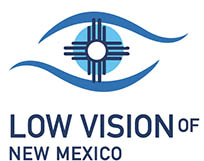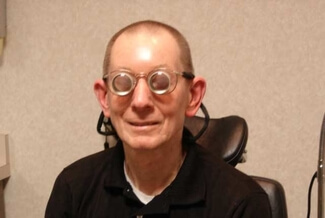
Low Vision Care for Macular Degeneration in New Mexico
At Low Vision of New Mexico, we take a different approach to Macular Degeneration. When you come to us you will begin to discover the things you can do rather than what you can’t because of your vision loss. Low Vision of New Mexico has helped countless patients with Macular Degeneration maximize their remaining vision and live joyful lives while doing things they value.
How We Help With Macular Degeneration
There are over 10 million people with Macular Degeneration in North America but that’s of little comfort when you’re one of them. Sooner or later, ophthalmologists and retinal specialists cannot offer any more treatments to improve your vision. At that point, you will ask yourself how life will go on. Will you be able to continue driving, reading, cooking, playing cards, or simply getting around without the assistance of others?
You have come to the right place for answers.
Dr. Dulce Walker, a low vision optometrist and member of the International Academy of Low Vision Specialists (IALVS) will help you optimize your remaining vision for the tasks and activities that matter to you most.
During a low vision exam, we will determine together what these activities are. We will then introduce you to the different devices and glasses that can optimize your vision for these specific tasks. Dr. Dulce Walker will work with you to evaluate which options are best suited to your needs, and help you understand what is possible and what isn’t.
What is Macular Degeneration?
The eye functions much like a camera. Light is projected onto the retina, which can be compared to wallpaper on the back of the eye’s interior. The retina consists of light-sensitive cells that are connected to the optic nerve. At the center of the retina, the sensory cells are particularly small and densely packed. This area is called the macula.
The macula is the part of the eye with which we see detail. In Macular Degeneration, the macula deteriorates and central vision deteriorates.
Although degeneration of the macula is mostly age-related, there are certain genetic diseases, including Stargard’s and Best disease, that affect the macula and can cause loss of central vision at a younger age.
Comfortable Vision Aids for Macular Degeneration
Specific low vision devices can achieve some of what your eyes no longer can. Low vision devices direct your focus onto an area of the retina that is healthy, provide magnification, filter light, or enhance contrast to provide you with better vision.
Examples of low vision glasses and different tasks for which they are useful:
Bioptic Telescope Glasses
One of the most popular types of low vision glasses are bioptic telescope glasses. Many people are able to drive using this device. A pair of miniature binoculars are mounted on top of your regular prescription glasses. To see detail, you simply tilt your head slightly down.
 E-Scoop Glasses
E-Scoop Glasses
These spectacles combine several features to improve vision specifically for Macular Degeneration patients: Magnification, a shift of focus onto a healthy part of the retina, a yellow tint to reduce glare and enhance contrast, and anti-reflective coating. E-Scoop glasses are ideal for use outdoors.
Prismatic Eyeglasses
These glasses enable many patients to read or carry out near-work. The lenses magnify and converge at the same time, allowing patients to see clearly up close. You can use prismatic glasses with a tablet or ebook-reader and for many activities that call for focus on a close object.
Full-diameter Telescopes
Going to the movies, or watching your grandchildren perform are pleasures people don’t want to miss. Full-diameter telescopes magnify and make an object appear closer. Patients can watch sporting events and enjoy theatre plays and other performances in which they are not required to move around.
Vision Loss Due to Macular Degeneration
When you have lost some of your vision because you have Macular Degeneration, low vision care and devices can allow you to remain independent and active. Contact us for more information on the many low vision glasses and devices designed to empower people like you.
Schedule an appointment with Low Vision of New Mexico to get your personal low vision exam. Share with us which activities you wish to do. We will show you ways that may enable you to carry out many of the activities on your wishlist.
We provide support for patients with low vision due to Macular Degeneration on the verge of losing hope. Don’t give up hope, visit Low Vision of New Mexico, and let us show you what is possible.
Dr. Dulce Walker at Low Vision of New Mexico treats patients from Albuquerque,Santa Fe,Las Cruces, Los Alamos and throughout New Mexico.
Questions & Answers About Macular Degeneration
Can I Drive With Macular Degeneration?
There are low vision glasses that enable low vision patients to drive. Whether these are suitable for you depends on two main factors: the level of your vision and the driving laws in your specific region. Consult Low Vision of New Mexico to provide you with detailed information.
Is Macular Degeneration Genetic?
One does not inherit age-related Macular Degeneration; however, people with a family history of the disease should make sure to get frequent eye examinations. There are some forms of Macular Degeneration that derive from a genetic disorder. Examples are Stargardt’s disease and Best disease. These affect younger patients and are also referred to as juvenile Macular Degeneration.
What Are the Symptoms of Macular Degeneration?
An eye exam that includes a dilated pupil test can usually detect Macular Degeneration before symptoms are apparent. The following could be signs of the disease:
- Straight lines appear distorted or wavy
- Reading and seeing detail becomes difficult in low light
- Increased sensitivity to glare
- A foggy central area in your vision
- Colors are pale
- Blurred vision
Can Macular Degeneration Be Prevented?
There are several known risk factors for age-related Macular Degeneration. Taking action to reduce the risks can help prevent, or at least slow the progression. Healthy eating habits that ensure a healthy blood pressure level are recommended. Smoking and extensive sun exposure should be avoided. Often patients in the early stages of Dry Macular Degeneration are advised to take specific vitamin supplements. The low vision optometrist can provide details.
What Is Dry Macular Degeneration?
Dry Macular Degeneration is by far the more common type. This condition is caused by deposits of yellow matter, called drusen, that form underneath the macula. As a result, the macula dries out and becomes thin. Patients with Dry Macular Degeneration experience limitations and distortions to their central vision.
What Is Wet Macular Degeneration?
Only about 10-15% of Macular Degeneration patients have the wet type. In this case, abnormal blood vessels form underneath the macula, which leak blood, causing the macula to lift. Patients experience a blind spot in their central vision. The condition can progress rapidly and cause significant vision loss.
Is Macular Degeneration Treatable?
For the dry type, there is no effective treatment available, and patients are advised to follow specific nutritional protocols, including supplements.
Treatments to slow down Wet Macular Degeneration usually require monthly injections or frequent laser treatments, which have many limitations.
Drug developments and research are advancing, with a number of clinical trials underway. Some notable approaches are anti-VEGF therapy or implants that aim at inhibiting an enzyme stimulating the growth of new blood vessels that cause blood leakage, gene therapy, and cell transplantation.
At the moment, there is no cure for either of the two types of Macular Degeneration. This is why it is important for you to see a low vision optometrist in addition to your medical doctor to help you manage the disease’s effects.
Happy Macular Degeneration Patient Uses Ocutech Autofocus 4x Falcon To Regain Visual Acuity
Resources
https://www.visionaware.org/default.aspx








